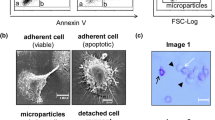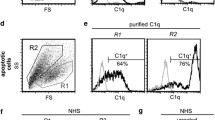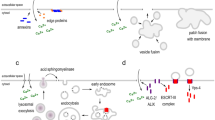Abstract
Complement-mediated nucleated cell death has been shown to be independent of colloid-osmotic swelling. In contrast, other factors (e.g. Ca2+ influx) are of importance in the induction of cell death. In this communication, the sequential morphological features of complement-mediated cell injury have been studied by electron microscopy and compared with biochemical data (ATP content and LDH release). It was observed that immediately after C5b-8 lesion formation, although the overall cell morphology is well preserved, the mitochondria display an “ultracondensed” appearance. Upon addition of C9, the mitochondria remain initially condensed, but swell progressively with final formation of flocculent densities. The nuclei become progressively edematous, with concurrent disappearance of heterochromatin. The nucleoli lose their associated chromatin and display segregation of their components with formation of markedly electron-dense filamentous deposits. The nuclear envelope remains initially intact, but subsequently progressive dilatation of the associated perinuclear RER cisterna and distention of the nuclear pores associated with leakage of chromatin into the cytoplasm are seen. The larger cell organelles (including mitochondria, ER, Golgi apparatus, etc.) become clustered around the nucleus, concurrently with marked edema of the outer cytoplasm and bleb formation. The RER cisternae become dilated, whereas the Golgi complex disappears. Relatively early on the plasma membrane shows breaks in continuity. The pattern of these changes — potentially related to Ca2+ influx, ATP efflux and overall metabolic depletion — corresponds to the previously described model of cell reaction to injury, confirming the dynamic nature of the process. The morphology of cell death in this model shares some features, e.g., the nucleolar changes, with “apoptosis” (programmed cell death). However, the overall pattern appears to correspond more to “necrosis,” characterized by loss of volume control and mitochondrial abnormalities.
Similar content being viewed by others
References
Campbell AK, Daw RA, Luzio JP (1979) Rapid increase in intracellular free CA2+ induced by antibody plus complement. FEBS Lett 107:55–60
Campbell AK, Daw RA, Hallett MB, Luzio JP (1981) Direct measurement of the increase in intracellular free calcium ion concentration in response to the action of complement. Biochem J 194:551–560
Carney DF, Koski CL, Shin ML (1985) Elimination of terminal complement intermediates from the plasma membrane of nucleated cells: the rate of disappearance differs from cells carrying C5b-7 or C5b-8 with a limited number of C5b-9. J Immunol 134:1804–1809
Deamer DW, Utsumi K, Packer L (1967) Oscillatory states of mitochondria. III. Ultrastructure of trapped conformational states. Arch Biochem Biophys 121:641–651
Duke RC, Chervenak R, Cohen JJ (1983) Endogenous endonuc-lease-induced DNA fragmentation: an early event in cell-mediated cytolysis. Proc Natl Acad Sci USA 80:6361–6365
Gunter TE, Pfeiffer DR (1990) Mechanisms by which mitochondria transport calcium. Am J Physiol 258 [Cell Physiol 27]:C755-C786
Hackenbrock CR (1966) Ultrastructural basis for metabolically linked mechanical activity in mitochondria. I. Reversible ultrastructural changes with change in metabolic steady state in isolated liver mitochondria. J Cell Biol 30:269–297
Hackenbrock CR (1968) Ultrastructural basis for metabolically linked mechanical activity in mitochondria. II. Electron transport-linked ultrastructural transformations in mitochondria. J Cell Biol 37:345–369
Kabat EA, Mayer MM (1961) Experimental immunochemistry. Thomas, Springfield, Ill
Kim SH, Carney DF, Papadimitriou JC, Shin ML (1989) Effect of osmotic protection on nucleated cell killing by C5b-9: cell death is not affected by the prevention of cell swelling. Mol Immunol 26:323–331
Koski CL, Ramm LE, Hammer CH, Mayer MM, Shin ML (1983) Cytolysis of nucleated cells by complement: cell death displays multi-hit characteristics. Proc Natl Acad Sci USA 80:3816–3820
Laiho KU, Trump BF (1975) Studies of the pathogenesis of cell injury: effects of inhibitors of metabolism and membrane function on the mitochondria of Ehrlich ascites tumor cells. Lab Invest 32:163–182
Laiho KV, Shelburne JD, Trump BF (1971) Observations on cell volume, ultrastructure, mitochondrial conformation and vitaldye uptake in Ehrlich ascites tumor cells. Effects of inhibiting energy production and function of the plasma membrane. Am J Pathol 65:203–217
Lehninger AL (1982) Principles of biochemistry. Worth Publishers, New York, pp 482–483
Lehninger AL, Carafoli E, Rossi CS (1967) Energy-linked ion movements in mitochondrial systems. Adv Enzymol 29:259–320
Luft JH (1961) Improvements in epoxy resin embedding methods. J Biophys Biochem Cytol 9:409–414
Marzella L, Trump BF (1992) Pathology of the cell: ultrastructural features. In: Papadimitriou JM, Henderson DW, Spagnolo DV (eds) Diagnostic ultrastructure of non-neoplastic diseases. Churchill Livingstone, Edinburgh, pp 46–83
Papadimitriou JC, Shin ML, Hänsch GM (1990) Mechanisms of complement-mediated membrane damage. In: Mergner WJ, Jones RT, Trump BF (eds) Cell death: mechanisms of acute and lethal cell injury, vol 1, chap 3. Field & Wood, Philadelphia, pp 67–85
Papadimitriou JC, Ramm LE, Drachenberg CB, Trump BF, Shin ML (1991a) Quantitative analysis of adenine nucleotides during the prelytic phase of cell death mediated by C5b-9. J Immunol 147:212–217
Papadimitriou JC, Phelps PC, Ramm LE, Drachenberg CB, Shin ML, Trump BF (1991b) Increased [Ca2+]i followed by failure of energy metabolism mediates Complement (C)-induced cell death in Ehrlich Ascites tumor cells (EATC) (abstract). (75th Annual Meeting, Federation of American Societies for Experimental Biology, Atlanta, Ga, 1991). FASEB J 5:A1670
Papadimitriou JC, Phelps PC, Ramm LE, Drachenberg CB, Trump BF, Shin ML (1991c) Loss of mitochondrial membrane potential and adenine nucleotide depletion during prelytic phase of C5b-9 attack on nucleated cell (abstract). (XIV International Complement Workshop, Cambridge, UK, 1991) Complement Inflamm 8:205
Papadimitriou JC, Carney DF, Shin ML (1991d) Inhibitors of membrane lipid metabolism enhance complement-mediated nucleated cell killing through distinct mechanisms. Mol Immunol 28:803–809
Papadimitriou JC, Phelps PC, Shin ML, Trump BF (1994) Effects of Ca2+ deregulation on mitochondrial membrane potential and cell viability in nucleated cells following lytic complement attack. Cell Calcium 15:217–227
Parce JW, Cunningham C, Waite M (1978) Mitochondrial phospholipase A2 activity and mitochondrial aging. Biochemistry 17:1634–1639
Ramm LE, Whitlow MB, Mayer MM (1982) Size of the trans-membrane channels produced by complement proteins C5b-8. J Immunol 129:1143–1146
Saladino AJ, Bentley PJ, Trump BF (1969) Ion movements in cell injury. Effect of amphotericin B on the ultrastructure and function of the epithelial cell of the toad bladder. Am J Pathol 54:421–466
Schwartzman RA, Cidlowski JA (1993) Apoptosis: the biochemistry and molecular biology of programmed cell death. Endocrine Rev 14:133–151
Seeger W, Suttorp N, Helwig A, Bhakdi S (1986) Noncytolytic terminal complement complexes may serve as calcium gates to elicit leukotriene B4 generation in human polymorphonuclear leukocytes. J Immunol 137:1286–1293
Shipley WU, Baker AR, Colten HR (1971) DNA degradation in mammalian cells following complement-mediated cytolysis. J Immunol 106:576–579
Thore A (1979) Technical aspects of the bioluminescent firefly luciferase assay for ATP. Sci Tools 26:30–34
Trump BF, Berezesky IK (1992) The role cytosolic Ca2+ in cell injury, necrosis and apoptosis. Curr Opin Cell Biol 4:227–232
Trump BF, McDowell EM, Arstila AU (1980) Cellular reaction to injury. In: Hill RB Jr, LaVia MF (eds) Principles of pathobiology, 3rd edn. Oxford University Press, New York, p 20
Venable JH, Coggeshall R (1965) A simplified lead citrate stain for use in electron microscopy. J Cell Biol 25:407–408
Waite M, van Deenen LLM, Ruigrok TJC, Elbers PF (1969) Relation of mitochondrial phospholipase A activity to mitochondrial swelling. J Lipid Res 10:599–608
Watson ML (1958) Staining tissue sections for electron microscopy with heavy metals. J Biophys Biochem Cytol 4:475–478
Author information
Authors and Affiliations
Rights and permissions
About this article
Cite this article
Papadimitriou, J.C., Drachenberg, C.B., Shin, M.L. et al. Ultrastructural studies of complement mediated cell death: a biological reaction model to plasma membrane injury. Vichows Archiv A Pathol Anat 424, 677–685 (1994). https://doi.org/10.1007/BF00195784
Received:
Accepted:
Issue Date:
DOI: https://doi.org/10.1007/BF00195784




